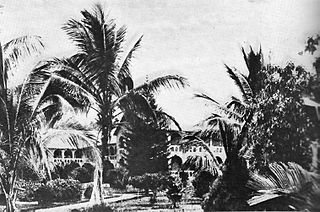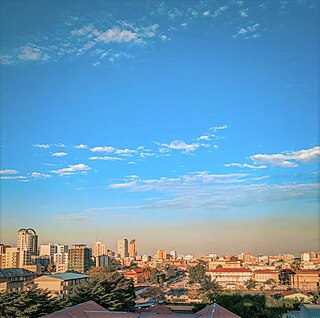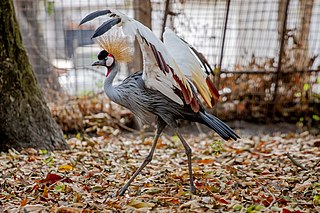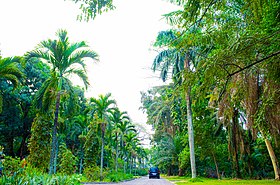
Kinshasa, formerly named Léopoldville before June 30, 1966, is the capital and largest city of the Democratic Republic of the Congo. Once a site of fishing and trading villages along the Congo River, Kinshasa is now one of the world's fastest-growing megacities. With an estimated population of 16 million residents, it's the most densely populated city in the DRC and the most populous city in Africa. It is Africa's third-largest metropolitan area and the leading economic, political, and cultural center of the DRC. Kinshasa houses several industries, including manufacturing, telecommunications, banking, and entertainment. The city also hosts some of DRC's significant institutional buildings, such as the Palais du Peuple, Palais de la Nation, Court of Cassation, Constitutional Court, Cité de l'Union Africaine, Palais de Marbre, Stade des Martyrs, Immeuble du Gouvernement, Kinshasa Financial Center, and multiple federal departments and agencies.

The Democratic Republic of the Congo is a country in Central Africa. By land area, the DRC is the second-largest country in Africa and the 11th-largest in the world. With a population of around 112 million, the Democratic Republic of the Congo is the most populous Francophone country in the world. The national capital and largest city is Kinshasa, which is also the economic center. The country is bordered by the Republic of the Congo, Central African Republic, South Sudan, Uganda, Rwanda, Burundi, Tanzania, Zambia, Angola, the Cabinda exclave of Angola, and the South Atlantic Ocean.

Étienne Tshisekedi wa Mulumba was a Congolese politician and the leader of the Union for Democracy and Social Progress (UDPS), the main opposing political party in the Democratic Republic of the Congo (DRC). A long-time opposition leader, he served as Prime Minister of the country on three brief occasions: in 1991, 1992–1993, and 1997. He was also the father of the current President, Felix Tshisekedi.

Kisantu, is a town in the western Democratic Republic of Congo, lying south west of Kinshasa, on the Inkisi River. It is known for its large cathedral and for its botanical gardens, which include an arboretum of indigenous trees.

The Stade des Martyrs de la Pentecôte, or simply the Stade des Martyrs, is the national stadium of the Democratic Republic of the Congo (DRC), located in the Kinshasa commune of the capital Kinshasa. With a seating capacity of 80,000, it is the largest stadium in the DRC and the fourth-largest stadium in Africa. It serves as the home stadium for the Congolese football national team, AS Vita Club, and DCMP, making it the largest multifunctional venue in the country.

Gombe, also known as La Gombe, or Downtown Kinshasa, is one of the 24 communes of Kinshasa, in the western part of the Democratic Republic of the Congo (DRC). Encompassing a vast area of approximately 29.33 square kilometers, it is home to an approximate population of 49,024 residents (2014).

The Boulevard du 30 Juin is a major 5‑km street in Kinshasa, Democratic Republic of the Congo (DRC). It is the city center's main transport artery, connecting the southern area of La Gombe with Kintambo and the Ngaliema to the west.

The Republic of the Congo was a sovereign state in Central Africa, created with the independence of the Belgian Congo in 1960. From 1960 to 1966, the country was also known as Congo-Léopoldville to distinguish it from its northwestern neighbor, which is also called the Republic of the Congo, alternatively known as "Congo-Brazzaville". In 1964, the state's official name was changed to the Democratic Republic of the Congo, but the two countries continued to be distinguished by their capitals; with the renaming of Léopoldville as Kinshasa in 1966, it became also known as Congo-Kinshasa. After Joseph Désiré Mobutu, commander-in-chief of the national army, seized control of the government in 1965, the Democratic Republic of the Congo became the Republic of Zaire in 1971. It would again become the Democratic Republic of the Congo in 1997. The period between 1960 and 1964 is referred to as the First Congolese Republic.

The Régie de Distribution d'Eau, abbreviated as REGIDESO, is a state-owned utility company located on Boulevard Du 30 Juin, in the Gombe commune of Kinshasa, Democratic Republic of the Congo (DRC). It is responsible for producing and distributing water throughout the national territory, encompassing both urban and rural areas. Established in 1929, REGIDESO operates autonomously within the Department of Mines and Energy under the government of the DRC.
Kinshasa is the capital and largest city of the Democratic Republic of the Congo. It is situated on the Congo river near Pool Malebo and forms a single urban area with Brazzaville which is the capital of the neighbouring Republic of the Congo. Considered a megacity, it is among the largest urban communities in Africa.

Kinshasa is a municipality (commune) in the Lukunga district of the city of Kinshasa, the capital of the Democratic Republic of the Congo. It is situated in the north of the city, south of Gombe and the Boulevard du 30 Juin.
MadimbaTerritory is a territory in the Kongo Central Province of the Democratic Republic of the Congo (DRC). Its seat is the town of Madimba. The region covers an area of 8,260 square miles and is situated 100 km from Kinshasa. It spans from the Lukusu River in the north to Kintano in the west, and from the Inkisi River in the west to Kinkosi-Luidi in the southeast. The territory borders Kasangulu Territory to the northeast, Kimvula Territory to the southeast, Mbanza-Ngungu Territory to the west, and Angola to the south. Madimba Territory is home to an approximate population of 463,132 residents.
The following is a timeline of the history of the city of Kinshasa, Democratic Republic of the Congo.

The Palais de la Nation is the official residence and principal workplace of the President of the Democratic Republic of the Congo. It is strategically situated in Gombe, north of Kinshasa, adjacent to the course of the Congo River, and has held its role since 2001, following the assassination of Laurent-Désiré Kabila.

Marcel Antoine Lihau or Ebua Libana la Molengo Lihau was a Congolese jurist, law professor and politician who served as the inaugural First President of the Supreme Court of Justice of the Congo from 1968 until 1975, and was involved in the creation of two constitutions for the Democratic Republic of the Congo.
Adrienne Ekila Liyonda was a Zairean politician who served as ambassador to Belgium and was the country's first female Foreign minister.

DR Congo–France are the bilateral diplomatic relations between the Democratic Republic of the Congo and France. Both nations are members of the Organisation internationale de la francophonie and the United Nations.

The Kinshasa National Zoological Park or Kinshasa Zoological Garden, also known as Kinshasa Zoo, is an animal park located in the Gombe commune, next to the Kinshasa Grand Market and the Kinshasa General Hospital in the Democratic Republic of the Congo (DRC). The zoo is home to over 30 species of animals, including mammals, reptiles, birds, fish, and amphibians, totaling more than 129 animals.

The Gare de l'Est, also known as Kinshasa Est or Kinshasa Central Station, is a central railway station situated in the Gombe commune of Kinshasa, Democratic Republic of the Congo (DRC). Positioned along the Matadi–Kinshasa Railway line, it functions as a pivotal transshipment point connecting the railway and the river. Managed by the Société Commerciale des Transports et des Ports, the station stands near Ngobila Beach at the Port of Kinshasa, fostering maritime links with Brazzaville, and is conveniently located close to SCTP buildings and the Ministry of Transport and Channels of Communication.

Formal diplomatic relations between Israel and the Democratic Republic of Congo have existed since 1962. Both countries are members of the United Nations. In 1973, like the majority of African countries that previously recognized Israel, Zaire decided to break its relations with Israel after the Yom Kippur War, but reestablished them, unlike other African countries, in the early 1980s.

















